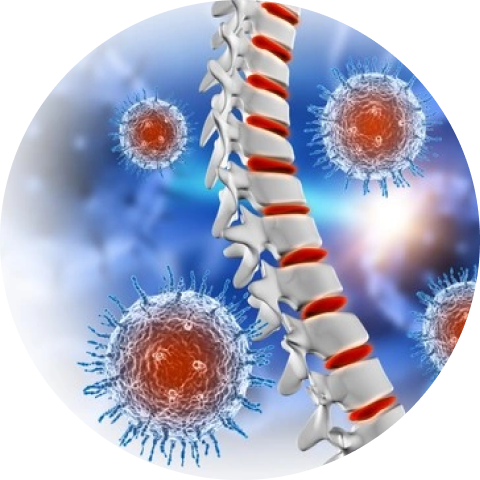Spondylodiscitis Spinal Infection

Table of Contents
- What is Spondylodiscitis?
- What Causes Spondylodiscitis?
- What Are The Symptoms Of Spondylodiscitis?
- Who are at Higher Risk Of Developing This Condition?
- Diagnosis, Treatments, And Management For Spondylodiscitis
- Why Choose Saijyot Raut For Spondylodiscitis Treatment
What is Spondylodiscitis?
Spondylodiscitis is a spine infection that primarily affects the disks and then pervades adjacent vertebrae through endplates. Pathogens causing it are called staphylococci. Spinal infections are caused by different pathogens that may be bacterial, fungal, or parasitic. Comprehensively spinal infections spondylodiscitis is a term referred to as vertebral osteomyelitis, spondylitis, and discitis.
Spondililodistis leads to other complications also such as osteomyelitis. Although it is a rare spinal infection condition, it is a serious condition with high morbidity and mortality rates. Therefore it is essential to seek early treatment from the orthopedic to contain its spread. You can seek help from our well-renowned spine surgeon in andheri, mumbai.
What Causes Spondylodiscitis?
As discussed above, spondylodiscitis is caused by various pathogens, including bacteria and fungi, diagnosed while treating patients. Staphylococci and Mycobacterium tuberculosis are the main causative organisms for it. The lumbar spine has more chances of infection than the thoracic spine. Spondylodiscitis occurs about 2-5% among osteomyelitis patients, and the prevalence increase with age.
Another common form of spondylodiscitis is tuberculous spondylodiscitis caused by mycobacterium tuberculosis.
What Are The Symptoms Of Spondylodiscitis?
The common symptoms caused by Spondylodiscitis include:
- Cervical lesion
- Spinal tenderness
- Restricted range of motions
- Paravertebral muscle spasm
- Limbs weakness to bear weight
- Epidural abscess formation
- Weight loss leading to spine erosion
- Limping postures
- Pain in movements such as crawl, sit or walk
- Abdominal or hip pain
- Incontinence of bladder and bowels
- Lumbar lordosis and restricted lower back movement
- Back or neck pain
- Constant pain, worsening at night
- Radicular pain, radiating to chest or abdomen as well
- Fever
- Other indications of spinal deformities, kyphosis, and Gibbs formation
- Neurological deficits: such as leg weakness, sensory deficit, paralysis, radiculopathy, and sphincter loss
Who are at Higher Risk Of Developing This Condition?
Some risk factors that can make someone prone to this condition are as follows:
- Cardiovascular diseases or prevalence of high blood pressure
- Obesity
- Drug abuse
- Regular steroid intake
- Alcohol and nicotine abuse
- HIV infection
- Catheter-associated infections or surgical interventions, increasing spondylolisthesis.
- Multiple morbidities
- Traumas or accidents requiring surgical interventions
- Chemotherapy or immunotherapy
- Cancer
- Bone TB
- Renal failure
- Liver failure: chronic hepatitis or liver cirrhosis
- Rheumatic diseases
Diagnosis, Treatments, And Management For Spondylodiscitis
The doctor asks the patient about their medical history, symptoms, as comorbidities. After this, the doctor prescribes multiple diagnostic tests to confirm the disease. The diagnosis includes:
- Conventional X-rays
- CT scans
- MRI
- Blood culture
- Cobb Angle test
The doctor prescribes other tests also to conclude the disease and percentage of infection.
- Leukocyte count
- C-reactive protein test
- PCR Method Bony Fusion Rate
- Bony Fusion Rate- To know where spinal fusion surgery would be feasible
Based on the above reports, the spine doctor plans the treatment.
Treatments
Conservative treatments
The conservative treatment is based on antibiotics and immobilization. It is recommended either when the risk is low to mild or when the patient is not fit for the surgery. The braces are given for Immobilization and allow bones to strengthen during treatment. However, prolonged bed-rest immobilization is discontinued for the treatment as it imposes some bad includes. Therefore, the children should be recommended only conservative treatments.
The conservative treatment ideally lasts for 6-8 weeks, and if the case does not improve, then doctor recommends other treatments.
Physical Therapy
Physical therapy helps in the nascent/early stages of spondylolisthesis. A certain set of exercises (involving specific muscle movement) specially designed by a physiotherapist is included with good dietary supplements. The exercises aim to strengthen the trunk, limbs, and lower back to ease pressure redistribution to surrounding muscles. The doctor will also recommend wearing a corset for 6-10 weeks to gain enough spine stability.
The early prognosis of the disease is very helpful for recoupment from diseases through physical therapy or conservative treatment.
Surgery
The surgery is recommended in The following cases:
- The severity of disease leading to infections in multiple spine chords
- Kyphosis due to infection
- The disease does not respond to conservative methods or require surgery in future stages.
- The disease was leading to other degenerative or spine disorders.
Our Spine Surgeon in Andheri, Mumbai performs surgical debridement and fixation procedures such as spinal fusion to eliminate the infectious part of the spine and join or stabilize the spine sections into one unit.
Why Choose Saijyot Raut For Spondylodiscitis Treatment
Spondylodiscitis is a rare infection with high morbidities and mortality rates. Therefore the doctor emphasizes only an early prognosis for help. Our doctor, Dr. Saijyot Raut, is a highly qualified and experienced spine specialist and pays detailed attention to the nuances of cases. He prescribes a detailed diagnosis to confirm the spine or orthopedic disorder and designs treatment logically. So, for accurate, remedy-oriented treatment, choose Dr. Saijyot Raut.
